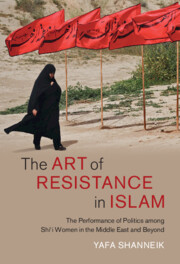 The Art of Resistance in Islam
The Art of Resistance in Islam Published online by Cambridge University Press: 06 January 2022
This chapter provides an overview of the trajectories of Shi‘is in the Gulf and their presence in Europe. The Shi‘a in the Gulf consist of indigenous as well as migrant and, in some cases, also converted Shi‘is. Whether forced or voluntary, the experiences of migration and settlement among Shi‘is in Europe and the Middle East varies. Often coming from minority contexts of marginalization, discrimination, and persecution, Shi‘i experiences of migration are often different to those of other Muslim immigrants in Europe as well as in the Middle East. In the 1980s, large-scale displacement of Iraqi Shi‘i Muslims, for example, forced them to migrate through a multilocal trajectory of displacement in so-called transit countries such as Iran, other Gulf countries or neighboring countries such as Jordan or came first to European countries such as Sweden, the Netherlands or Germany and later moved to the United Kingdom. The national and transnational interactions and networks of these Shi‘i communities are discussed in this chapter to offer an overview of the various diverse Shi‘i communities present in Europe and the Middle East.
To save this book to your Kindle, first ensure [email protected] is added to your Approved Personal Document E-mail List under your Personal Document Settings on the Manage Your Content and Devices page of your Amazon account. Then enter the ‘name’ part of your Kindle email address below. Find out more about saving to your Kindle.
Note you can select to save to either the @free.kindle.com or @kindle.com variations. ‘@free.kindle.com’ emails are free but can only be saved to your device when it is connected to wi-fi. ‘@kindle.com’ emails can be delivered even when you are not connected to wi-fi, but note that service fees apply.
Find out more about the Kindle Personal Document Service.
To save content items to your account, please confirm that you agree to abide by our usage policies. If this is the first time you use this feature, you will be asked to authorise Cambridge Core to connect with your account. Find out more about saving content to Dropbox.
To save content items to your account, please confirm that you agree to abide by our usage policies. If this is the first time you use this feature, you will be asked to authorise Cambridge Core to connect with your account. Find out more about saving content to Google Drive.